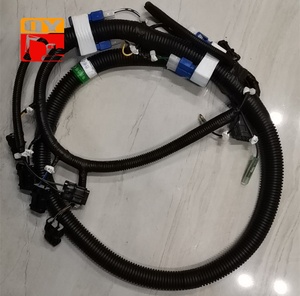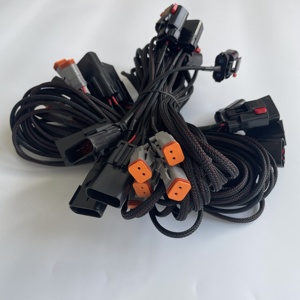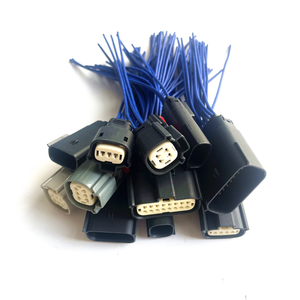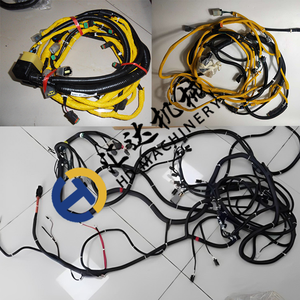
All categories
Featured selections
Trade Assurance
Buyer Central
Help Center
Get the app
Become a supplier

(782 products available)


































The PC200-8 excavator wiring harness is a crucial component of the PC200-8 excavator's electrical system. It transmits signals and power between different parts, facilitating the communication of electronic components. Several wiring harness types are typically manufactured for different parts of the excavator machine and may include the following:
Main Wiring Harness
This is the large, complex cable assembly that serves as the primary electrical communication channel throughout the excavator. It connects the machine's different parts, such as the engine, control panel, sensors, and actuators. The main wiring harness ensures that power and signals flow between these components, enabling proper excavator functionality and operation.
Engine Wiring Harness
The engine wiring harness connects various engine components, such as the engine control unit (ECU), sensors, and actuators. It helps transmit engine management signals, allowing the ECU to receive data from the sensors and control engine functions through the actuators. This enables the excavator's engine to perform optimally and efficiently.
Sensor Wiring Harness
The sensor wiring harness links the excavator's sensors to the control system or ECU. It connects sensors like temperature sensors, pressure sensors, and position sensors, among others. By transmitting the sensors' signals to the excavator's control system, the sensor wiring harness aids in relaying essential information regarding the machine's operational conditions, thereby facilitating monitoring and decision-making.
Operator Cabin Wiring Harness
This wiring harness links the excavator's cabin components to the rest of the machine. It connects items like as switches, gauges, monitors, and controls located within the operator's cabin. The operator cabin wiring harness gives the operator access to monitor and manage the excavator's functions by connecting the cabin components to other excavator systems.
ECU Wiring Harness
The ECU (Electronic Control Unit) wiring harness connects the excavator's ECU to its various components. The ECU serves as the machine's brain and is responsible for regulating and managing its operations. The ECU wiring harness ensures that the ECU receives input from different sensors and permits communication with other actuators and devices by linking the ECU to its components.
Material
Matsushita Wiring Harness is made of copper core plastic, and the plug is made of nylon, which can resist high and low temperatures. The copper core material ensures good conductivity and bandwidth transmission.
Length
The excavator wiring harness is available in different lengths to suit different excavator models and configurations.
Shielding
The PVC or PU shield outside the wiring harness can improve abrasion resistance and waterproof performance. Additionally, it can achieve high and low-temperature resistance, oil resistance, fire retardant, and anti-bother function.
Connector
The harness is equipped with various connectors, such as plugs and sockets, to ensure reliable connections between different wiring.
Bundling Methods
The wiring harness uses bundling methods such as tape, clips, or bundles to neatly bundle and secure the wires.
Environmental rating
Wiring harnesses are often rated by environmental protection levels to ensure that they can function properly in harsh environments. This excavation wiring harness has IP67 waterproof and dustproof ratings.
Cleaning method: Regular cleaning and maintenance of the wiring harness helps to keep its appearance and prevent the accumulation of dirt and debris.
Visual inspections: Regular visual inspections of the wiring harness help to discover potential problems in time, such as fraying, bending, cracking, etc.
Avoid over-bending: Properly preserve the shape of the wiring harness to avoid damaging the internal conductor and preventing the use of excavator wiring harnesses.
Avoid exposure to high temperatures: Protect the wiring harness from exposure to high temperatures to avoid damage or deformation. High heat can also affect the insulation of the wiring harness, leading to potential safety hazards.
Prevent moisture ingress: Regular check and maintenance of the wiring harness to avoid moisture ingress. Keeping the wiring harness dry can avoid mold breeding and corrosion of the internal conductor.
The multi-pin excavator wiring harness connects various electronic components, with job site safety being paramount. In the mining sector, pressure bulge is part of daily work. Precise, pressure-resistant parts are essential. In tunneling, excavators dig horizontally underground to create tunnels for transportation or water transmission; deformation control is vital to maintain tunnel stability. In remote areas, long-distance open-pit mining requires excavators to operate far from power sources, making reliable wiring harnesses essential for machinery functionality.
Precise wiring connections are crucial for harness performance. In the construction of large civil engineering infrastructure projects, excavator wiring harnesses are essential for excavators, loaders, and other equipment connecting sensors, ECUs, and driver components. Low-temperature performance is critical for open-pit mining in winter, with excavator wiring harnesses needing to withstand cold conditions. In the infrastructure telecommunications sector, excavator wiring harnesses are vital for connecting telecommunication nodes and cables. Dust-proof and water-proof, excavator wiring harnesses prevent contaminants that impact device performance. Road maintenance involves frequent equipment transfer, requiring versatile excavator wiring harnesses.
In underground ore mining, excavation volumes are significant, and equipment must operate reliably, with excavator wiring harnesses connecting diverse machinery. Excavator wiring harnesses are also crucial for cable cars that transport ore. We know that safety, reliability, and durability are paramount in the offshore oil industry. Excavator wiring harnesses facilitate cable/ship offshore drilling and excavation and waterproof connectors. In the excavation of hydropower engineering projects, excavators dig to install underwater concrete and put in place the underwater cofferdam.
In the offshore wind power industry, excavators are used to dig foundations for offshore wind farm towers and cables. Open-pit mining often involves large volumes of work and sinking pits; excavators dig pits to dewater mines. Excavators perform site leveling, trenching, and other tasks, relying on excavator wiring harnesses to connect crucial operational components. On agricultural and landscaped farms, excavators excavate for olive grooves and wells, including the braiding of low-energy irrigation systems.
Wiring harnesses are important components of an excavator that ensure efficient equipment operation. When considering the wiring harness for the excavator, several key factors must be considered to get the most suitable for the equipment.
Q1: What is an excavator wiring harness?
A1: The excavator wiring harness is a network of wires that connects the various electrical components of the excavator, such as the PC200-8 excavator engine wiring harness sensors, switches, and controllers, allowing them to communicate and function properly together.
Q2: What are the signs of a damaged wiring harness?
A2: A damaged excavator wiring harness may cause the PC200 excavator to have difficulty starting, irregular engine behavior, operate inconsistent equipment, or malfunctioning of the excavator's electrical features. Physical damage such as fraying, pinching, or cracking may be visible on the wiring harness. There may also be ECU errors. These are some common signs that the wiring harness is damaged or faulty. If this occurs, please contact the technician and replace the wiring harness as soon as possible to ensure the excavator works well.
Q3: Why is the PC200-8 wiring harness important?
A3: The PC200-8 wiring harness plays a crucial role in excavators or other machines. It protects and organizes the wiring, ensures proper connection and communication between electrical components, and allows the excavator to operate smoothly and efficiently.
Q4: What are the different types of wiring harnesses for excavators?
A4: The excavator wiring harness can be divided into several types according to different classification methods, such as the use of functional classification, structural harness classification, connection mode, etc. For example, the excavator sensor wiring harness is responsible for connecting the sensors to the excavator's control system. Another example is the operator seat control wiring harness, which connects the controls that the operator uses to maneuver the excavator.